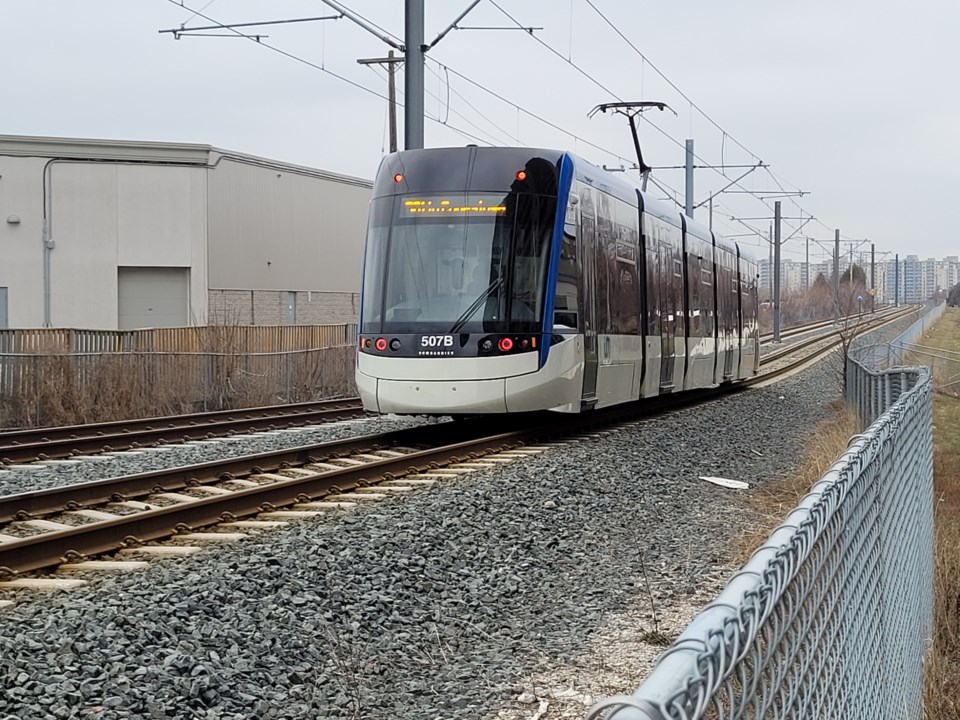Public consultation will begin in May on what the community would like to see move forward in the business case for Stage 2 of light rail transit (LRT) coming to Cambridge.
Interim commissioner of transit Doug Spooner gave the update this morning following a report monitoring positive change in the central transit corridor since the ION's inception.
Spooner reminded council that Stage 2 to Cambridge remains in "initial business case mode" with a selection of options including do nothing, light rail transit as proposed, or a bus-rapid transit option.
"The plan for this year is to begin our public conversation in May, get some initial public feedback, and be here in Q4 with the costed initial business case looking for your support on an option in order to move to next steps," he said.
Sounding surprised that a rapid bus option was still on the table, Coun. Doug Craig said it's not an optimal solution to making transfer connections to the ION in Kitchener.
Following the meeting, Craig said he fears keeping the bus-rapid transit option on the table, including what he expects would be a significant cost differential, could "prejudice the whole thing" toward rapid bus.
The anticipated cost of laying track and adding trains for Stage 2 between Fairview Park mall and the Ainslie Street bus terminal is $4.5 billion.
Spooner said regardless it has to be looked at as part of the economic analysis for Stage 2.
Ryan Pogrzeba, the region's manager for growth monitoring and analytic services, said monitoring change in the central transit corridor is essential to understanding the changing nature of the corridor's demographics, environment, social makeup and economic impact.
"Understanding these evolving characteristics allow us, the cities of Cambridge, Kitchener and Waterloo and our many partners, to best respond to the changing community, including policies, programs, resources and tools."
Highlights of the report included growth in post-pandemic transit ridership on both bus and ION routes, with overall ridership up 20 per cent above pre-pandemic levels during peak system usage in the fall of 2022.
The increased use of transit is estimated to have led to a 33 per cent decrease in greenhouse gas emissions per capita for passenger transportation since 2011.
At the same time the region's urban population increased by 22 per cent since 2011, GHG emissions decreased from 1.4 million tonnes to 1.1 million tonnes in 2023, explained Pogrzeba.
Between 2022 and 2023, the population within the central transit corridor increased at a faster rate than outside the Kitchener and Waterloo cores, more than doubling the 3.1 per cent growth rate in the suburbs.
About one in five people in the region now reside in the CTC.
The central transit corridor is also the reason for about 28 per cent of new construction value in 2023.
Permits were issued for 2,212 new residential units and 206,000 square feet of new industrial, commercial, and industrial floor space.
The total cumulative building permit value in the corridor since 2011 is $4.9 billion.
Pogrzeba said the number of new developments and renovations are evident in assessment value growth of $10 billion in 2011 to more than $19.5 billion in 2023, an average annual increase of nearly $830 million.
Municipal taxes generated on properties within the CTC were estimated at $258 million in 2023, 93 per cent higher than in 2011.
As the region heads into planning for Stage 2, Coun. Jim Erb asked what the region could be doing differently to encourage more affordable housing development along the central transit corridor, because "really, those are the folks that need it."
There hasn't been a lot of development along those lines in the corridor, agreed region's commissioner of planning, development and legislative services, Rod Regier.
"I think it does point to the need for us to think strategically about land acquisition as we are planning out the development of Stage 2," he said.
Regier said council made recent moves to acquire strategic parcels of land in Cambridge that could be considered.
The anticipated level of investment in market oriented housing is something the region will need to consider going forward, he added.
Coun. Pam Wolf wanted to know if there's been any noticeable move toward intensification along the planned LRT route to Cambridge yet.
Although some intensification is beginning to show along the Hespeler Road corridor in anticipation of Stage 2, including planned redevelopment of the Cambridge Smart Centre, said Pogrzeba, the majority of the site plans along the corridor are in Kitchener because of the existing infrastructure.
"We predict we'll see a similar trend in Cambridge," he said.



